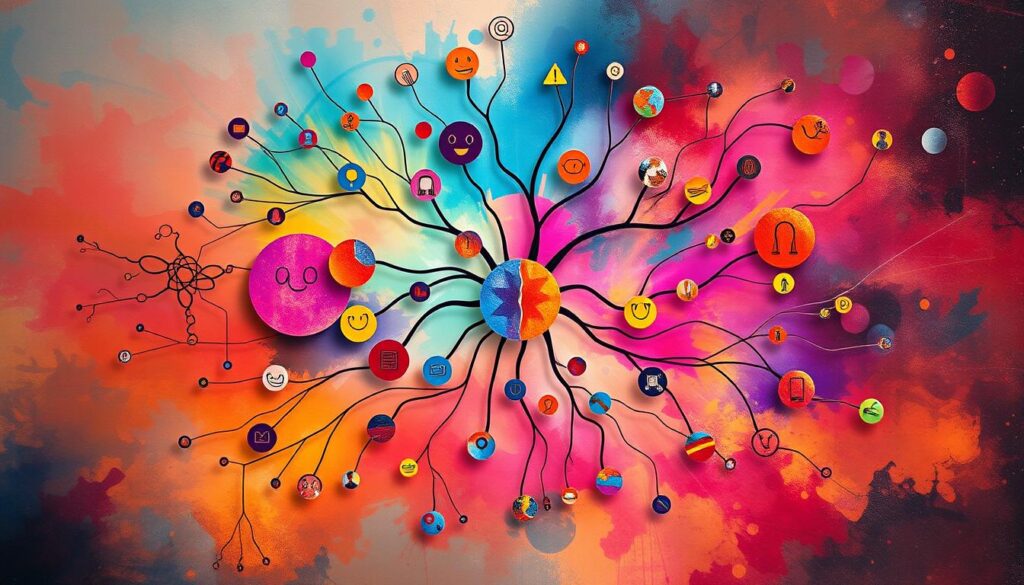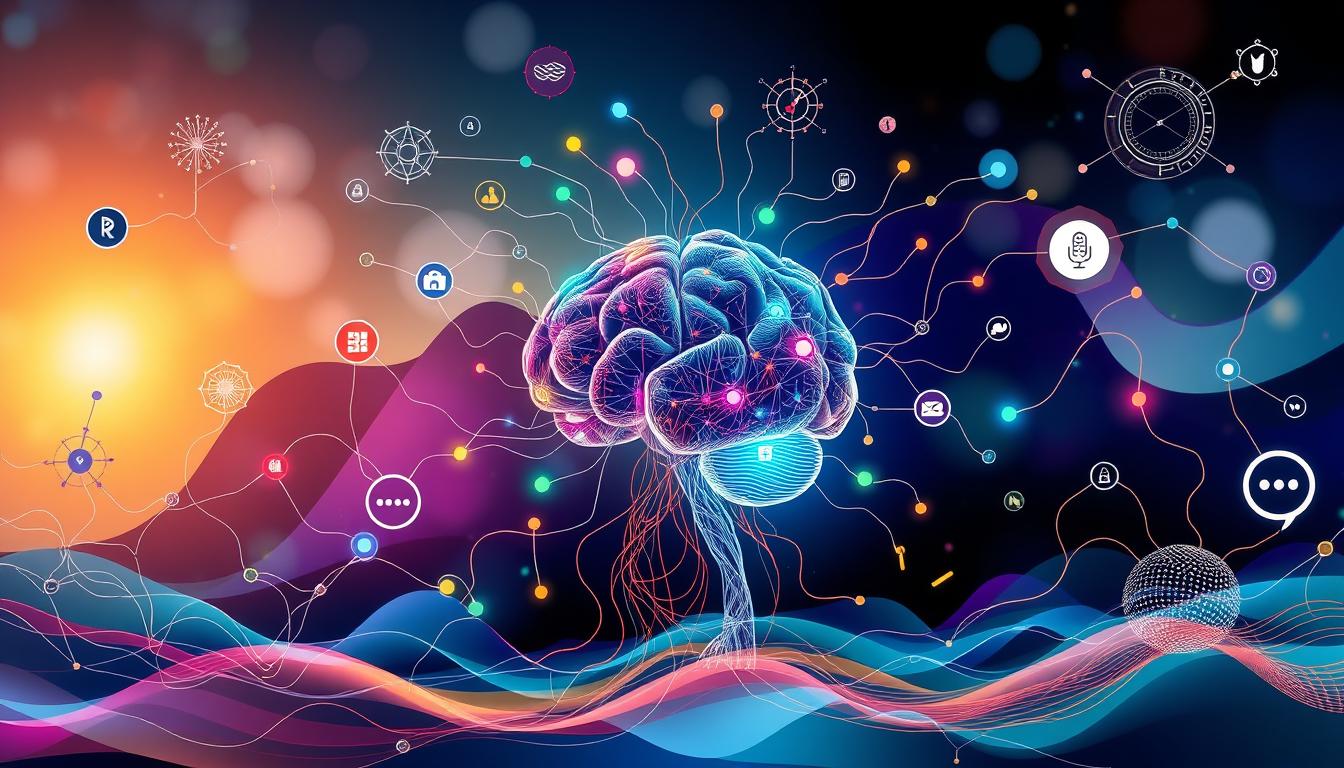“The way we communicate with others and with ourselves ultimately determines the quality of our lives.” – Tony Robbins, renowned author and life coach.
Imagine being able to connect with others easily. You can share your ideas clearly and confidently. And you can handle tough conversations with no problem. This is what Neuro-Linguistic Programming (NLP) can do for you.
NLP explores how our brains, language, and actions are linked. By using these techniques, you can tap into your mind’s power. This can change your life for the better, both personally and professionally.
Key Takeaways
- NLP techniques empower you to associate positive emotions with specific stimuli, boosting confidence and clarity in communication.
- By breaking down complex information and reframing negative patterns, NLP helps you convey ideas more effectively.
- NLP techniques enable you to understand and imitate the communication styles of successful individuals, transforming your own interactions.
- Applying NLP can help you overcome communication barriers, build stronger relationships, and achieve greater personal and professional success.
- NLP’s focus on understanding thought and behavioral patterns equips you with the tools to make lasting, positive changes in your life.
Understanding the Power of Neuro-Linguistic Programming
Neuro-Linguistic Programming (NLP) changes how we talk and connect with others. It was created in the 1970s by Richard Bandler and John Grinder. They found that changing our thoughts and actions can greatly improve our lives.
Origins and Development of NLP
NLP started at the University of California, Santa Cruz. Bandler and Grinder used insights from linguistics, psychology, and communication. Today, many, like motivational speaker Tony Robbins, use NLP in their work.
Core Principles Behind NLP
- Rapport Building: Creating a strong connection by mirroring and pacing others.
- Sensory Acuity: Noticing nonverbal cues and environmental factors that affect communication.
- Anchoring: Linking certain feelings or actions to specific triggers, making them easy to recall.
- Language Pattern Recognition: Adapting to the unique ways people communicate.
The Science of Communication Patterns
NLP is based on understanding the hidden signals in our communication. Research shows that body language is key, followed by tone of voice and words. By learning NLP, you can better read these signals and connect more deeply with others.

“The way we communicate with others and with ourselves ultimately determines the quality of our lives.” – Tony Robbins
Essential NLP Techniques for Effective Communication
Neuro-linguistic programming (NLP) is a powerful tool for better communication. It was created in the 1970s by Richard Bandler and John Grinder. It helps bridge communication gaps and build strong connections. Let’s look at some key NLP techniques to improve your communication skills.
Anchoring and State Management
Anchoring links specific emotions to certain triggers. This way, you can quickly feel those emotions when needed. It helps you manage your feelings, making your communication better.
Mirroring and Rapport Building
Mirroring involves matching someone’s body language and speech. It makes you feel more comfortable and familiar. This helps you connect deeply and have meaningful conversations.
Language Pattern Recognition
NLP also teaches you to understand speech better. By recognizing language patterns, you can grasp the true meaning behind words. This skill makes your conversations more effective and persuasive.
Learning these NLP techniques will help you in many communication situations. They can improve your speech recognition, sentiment analysis, and overall communication techniques. NLP offers a powerful way to enhance your communication skills.

“The way we communicate with others and with ourselves ultimately determines the quality of our lives.”
Mastering the Art of Active Listening
In Neuro-Linguistic Programming (NLP), active listening is key to good communication. It’s more than just hearing words; it’s about fully getting the message. This skill leads to understanding, meaningful responses, and deeper connections.
Learning active listening takes patience and practice. It helps you become a better listener and grow personally and professionally.
The Importance of Presence and Sensory Acuity
Presence is at the core of active listening. Being fully present lets you focus on the speaker’s words and body language. Noticing small changes in someone’s body can give you insight into their feelings.
Cultivating Engaging Conversations
Active listening is about more than just listening. It’s about creating a two-way conversation. Asking open questions and paraphrasing shows you’re interested and helps build trust.
The Benefits of Active Listening
Mastering active listening brings many benefits. It improves problem-solving and strengthens relationships. It can change your life for the better by making you a better communicator and more empathetic person.
| Key Aspect | Benefit |
|---|---|
| Presence and Sensory Acuity | Gain valuable insights into the speaker’s emotional state and enhance understanding. |
| Engaging Conversations | Build trust, resolve conflicts, and improve teamwork through dynamic exchanges. |
| Problem-solving and Empathy | Enhance your ability to understand and address challenges, while fostering stronger connections. |
“The most important thing in communication is to hear what isn’t being said.” – Peter Drucker
Active listening can change how you communicate and grow. Start this journey and see how it can positively impact your life.
Building Rapport Through Body Language and Mirroring
Effective communication is more than just words. In fact, studies show that 93% of what we communicate is through body language and tone. By learning body language and mirroring, you can build strong rapport with others.
Understanding Non-verbal Cues
Start by watching your partner’s body language, gestures, and facial expressions. Paying attention to these cues helps you connect better. Notice small things like hand gestures and eye contact to understand their feelings and how they like to communicate.
Matching and Pacing Techniques
Mirroring and matching your partner’s body language and tone can help a lot. Try to match their breathing, speaking speed, and energy. But don’t copy them exactly. This can make them feel uncomfortable. Use these techniques carefully to keep the conversation flowing smoothly.
Creating Emotional Connection
The main goal is to connect emotionally with your partner. Use sensory words that match their communication style. This way, you can understand them better and build a stronger bond. It makes your interactions more real and meaningful, whether at work or with friends.
The true power of communication is in how we express ourselves. By mastering body language and mirroring, you can create lasting rapport. This helps you connect deeply with everyone around you.
Advanced NLP Techniques for Personal Development
Unlock your full potential with advanced Neuro-Linguistic Programming (NLP) techniques. NLP goes beyond the basics, offering sophisticated methods for growth and self-improvement. Explore visualization, the Meta Model, and cold reading to change your thoughts, emotions, and actions.
Visualization is a powerful NLP method. It uses your mind’s eye to picture desired outcomes. This helps you overcome obstacles and plan for success. Imagine achieving your goals to guide your actions and decisions.
The Meta Model is another advanced NLP approach. It helps you question assumptions and challenge limiting beliefs. This clarity deepens your understanding of yourself and others. Mastering it boosts your conversation skills and confidence.
Interested in human behavior? Try cold reading, guessing someone’s personality or situation from their body language. While it should be used carefully, it offers insights that improve your social skills and emotional intelligence.
Start your journey with these advanced NLP techniques. They will help you overcome challenges, become more self-aware, and build strong connections. Use your mind’s power to open up a world of possibilities.
| NLP Technique | Description | Benefits |
|---|---|---|
| Visualization | Using mental imagery to overcome challenges and create positive outcomes. | Enhances motivation, focus, and goal achievement. |
| Meta Model | Identifying and questioning underlying assumptions to ensure clarity of communication. | Promotes self-awareness, critical thinking, and effective problem-solving. |
| Cold Reading | Making accurate guesses about someone’s personality or situation based on their nonverbal cues. | Develops emotional intelligence and enhances interpersonal skills. |
Discover the transformative power of advanced NLP techniques. Elevate your personal growth journey and see the significant impact these tools can have on your life.
Implementing NLP in Professional Settings
Neuro-Linguistic Programming (NLP) can change how you talk and work. It helps you lead better and solve problems at work. By learning NLP, you can influence more and lead with confidence.
Business Communication Enhancement
Good communication is key to success at work. NLP teaches you to speak and act in ways that influence others. It uses speech recognition and sentiment analysis to improve your communication. This way, you can connect better with your team and clients.
Leadership and Influence
NLP boosts your leadership skills. It helps you understand how your actions and words affect others. By mastering NLP, you can lead with empathy and inspire your team to do great things.
Conflict Resolution Strategies
Dealing with work conflicts can be tough. But NLP has strategies to help you find solutions. It teaches you to listen well and see things from different angles. This way, conflicts can lead to growth and teamwork.
Using NLP at work opens up many opportunities. It improves your communication, leadership, and conflict-solving skills. These techniques can help you succeed and find happiness in your career.
“NLP is the study of the structure of subjective experience. It’s about how we think, how we feel, how we behave, and how we communicate with ourselves and with others.”
– Richard Bandler, Co-Creator of Neuro-Linguistic Programming
Transforming Relationships Through NLP
Neuro-Linguistic Programming (NLP) can change your relationships for the better. It helps you communicate better, connect emotionally, and handle tough situations with kindness. By learning NLP, you can improve how you talk to others and feel closer to them.
NLP teaches us to see things from different points of view. This helps us understand our partner’s feelings better. It makes solving problems easier and turns negative situations into chances for growth.
- Reframing: NLP helps you see things in a new light. This way, you can respond with kindness and find good solutions.
- Rapport Building: Learning to mirror and pace builds trust and understanding with your partner. It makes your connection stronger.
- Emotional Intelligence: NLP values emotional smarts. It helps you understand people better and respond with empathy.
- Active Listening: NLP’s focus on listening well makes conversations better. It helps you really get what your partner is saying.
- Anchoring: This NLP trick links physical feelings to emotions. It helps you find positive feelings when you’re stressed or upset.
Using NLP in your relationships can change how you talk, solve problems, and connect with others. It’s great for both personal and work relationships. NLP can really make a difference.
| NLP Technique | How it Can Transform Relationships |
|---|---|
| Reframing | Helps shift perspectives, leading to more constructive problem-solving |
| Rapport Building | Fosters trust, understanding, and emotional connection |
| Emotional Intelligence | Enhances empathy, sensitivity, and the ability to navigate interpersonal dynamics |
| Active Listening | Improves the quality of conversations and helps address partner’s needs |
| Anchoring | Provides access to resourceful emotions during times of conflict or stress |
Discovering NLP can open up new possibilities in your relationships. It helps you build stronger, more meaningful connections with those you care about.
“Neuro-Linguistic Programming (NLP) is the study of human excellence. It’s about understanding how people think, communicate, and behave, and then using that understanding to improve the quality of our lives.”
Unleash the Power of NLP for Your Relationships
Want to improve your relationships? Check out our NLP Level 2 Certification Course. It teaches you how to use NLP in your life. Contact OLCA Coaching Limited, a top coaching academy in Africa, to start your NLP journey today.
Overcoming Communication Barriers with NLP
Good communication is key to strong relationships. But, talking to others can be tricky. Neuro-Linguistic Programming (NLP) helps you get better at it. It makes you understand people better and feel more confident when you talk.
Identifying Communication Blocks
First, find out what’s holding you back. NLP shows you how to spot hidden messages and small details that mess up talks. Knowing these helps you fix them and talk better.
Reframing Negative Patterns
NLP teaches you to see challenges as chances to grow. Instead of focusing on the bad, look at the good. This way, you can overcome old beliefs and start fresh in your conversations.
Building Communication Confidence
Being confident is important for good communication. NLP gives you tools like anchoring and mirroring to feel more sure of yourself. With these, you can turn talking into a chance for success.
Using NLP can really change how you talk to others. It helps you spot problems, change your view, and feel more confident. This way, you can make deeper connections, solve problems, and reach your goals more easily.
“The quality of your life is the quality of your communication.” – Tony Robbins
Start a new journey in communication with NLP. It opens doors to new possibilities in your life and work.
Conclusion
The nlp techniques we’ve talked about can really change how you talk to others. They help you listen better, build connections, and use NLP in many ways. This can make your communication skills much stronger.
These methods can help you persuade others, solve problems, or feel more confident when you talk. NLP gives you tools for all these areas. By using these techniques, you can improve your relationships and open up new chances for growth.
Starting to learn nlp techniques and improve your communication skills is exciting. The key is to be open to new ways of talking and really connect with people. With effort and practice, you can change how you talk and make a big difference in the lives of others.
FAQ
What are the key benefits of using NLP techniques to enhance communication skills?
NLP techniques help by linking positive feelings to certain things. They break down hard information and change how we see things. They also let us copy the best communicators.
These methods help us deal with bad feelings, feel more confident, and share complex ideas clearly.
What is the origin and core principle behind Neuro-Linguistic Programming (NLP)?
NLP started in the 1970s by Richard Bandler and John Grinder. It’s based on changing thoughts and actions to improve ourselves. It shows how language and behavior are linked, especially in talking skills.
What are some of the essential NLP techniques for effective communication?
Key NLP techniques include anchoring and mirroring. Anchoring links good feelings to things. Mirroring matches someone’s body language and words to build rapport.
Understanding and using good communication patterns is also crucial.
Why is active listening a critical communication skill in NLP?
Active listening means really getting what the speaker says, both in words and body language. It helps us understand better, respond well, and connect with others.
How can building rapport through body language and mirroring enhance communication?
Building rapport means using non-verbal cues and mirroring. Mirroring someone’s body language and words helps us connect and understand each other better.
What are some advanced NLP techniques for personal development?
Advanced NLP includes visualization and the Meta Model. Visualization uses images to tackle challenges and achieve goals. The Meta Model helps clear up misunderstandings by questioning assumptions.
Cold reading is guessing about someone’s personality or situation based on their body language.
How can NLP techniques be applied in professional settings?
In work, NLP boosts confidence, reduces stress, and increases productivity. It helps in communication, understanding our impact, and being aware of our patterns. This is useful in negotiations, presentations, and team management.
How can NLP transform relationships by enhancing communication skills and emotional intelligence?
NLP techniques like reframing change how we see things and manage emotions. They help in overcoming relationship challenges. NLP teaches us to see things from others’ perspectives, leading to better communication in all areas of life.
What are the key steps in the NLP process for overcoming communication barriers?
The NLP process includes steps like recognizing unconscious messages and focusing on key details. It also involves using positive words and building optimism. These steps help achieve communication goals and overcome obstacles.




























































